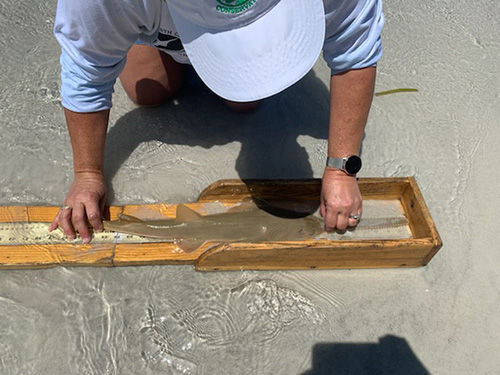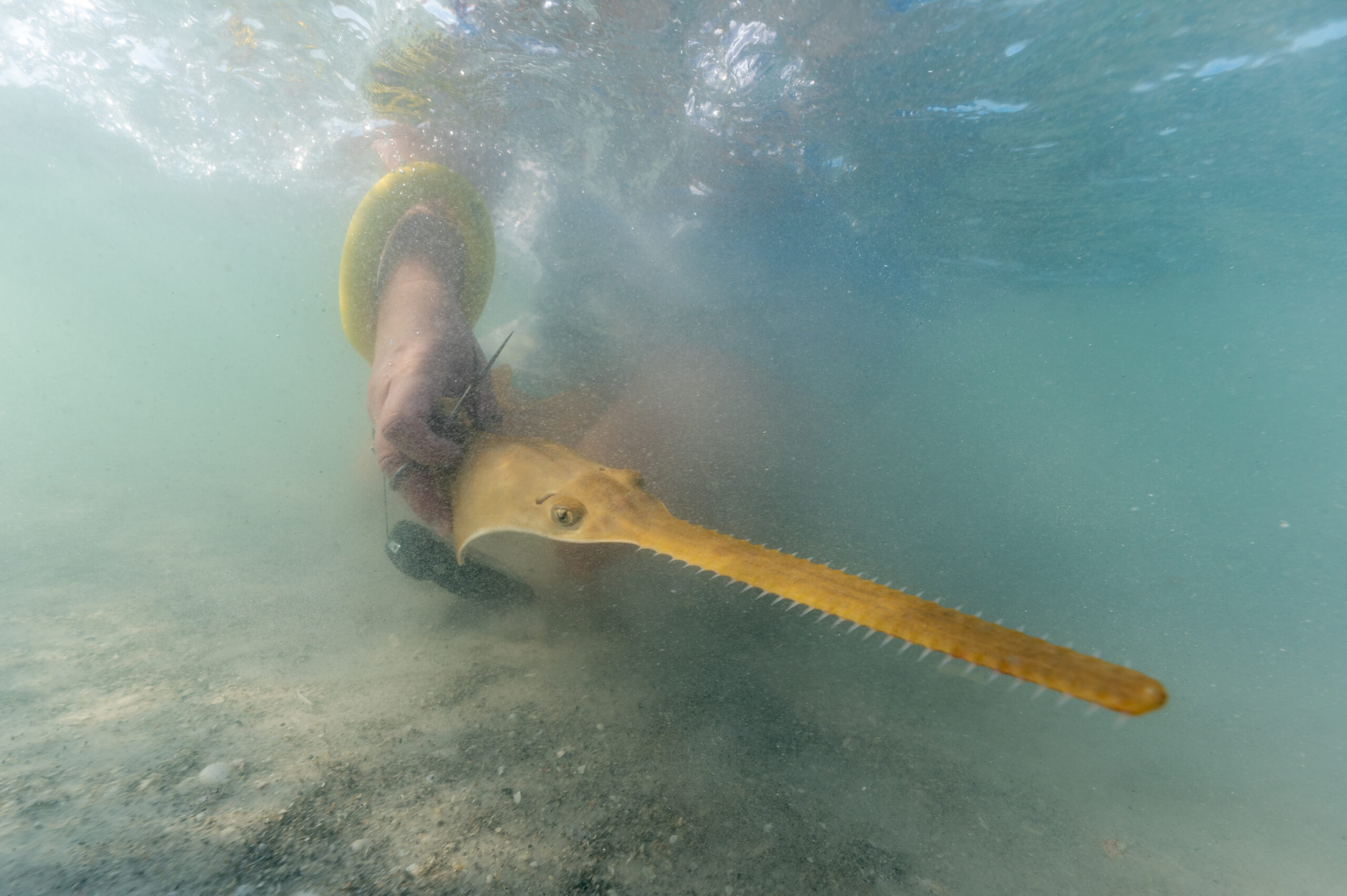First Sawfish Tagged in Tampa Bay!
I saw the email first thing Friday morning; a sawfish had been sighted in the Tampa Bay area. A man walking the beach in Redington Shores the day before had filmed a small sawfish swimming in the shallow surf zone. Thanks to all the outreach I’ve done in the area (partly funded by Save Our Seas Foundation) he knew to share the details of his sawfish observation with us and submitted the video and location information to sawfish@myfwc.com. Andrew Wooley, who facilitates the sawfish hotline for Florida Fish and Wildlife Conservation Commission, promptly forwarded the email to me since the sawfish was in my study area.
Reports of sawfish in the Tampa Bay area rare, especially newborn-sized sawfish, so it was critical to respond quickly. I promptly loaded my car with all the gear needed to catch, tag, and release the sawfish if we could find it; though experience suggested this would be a proverbial needle in a haystack scenario. Adam Brame, the NOAA Fisheries U.S. sawfish recovery coordinator, and I were at the location within two hours to start our search. We hit the beach and walked in opposite directions to maximize effort searching for the tiny sawfish in the shallow, coastal water. Within minutes Adam called me, he had found it!! I raced to his location and was astonished to see this little 73 centimetre (28 inches) long sawfish in front of me. After easily catching it in a dip net, we quickly collected several measurements, determined it was a female from the absence of claspers at the pelvic fins, tagged her with external and internal identification and tracking tags, collected a small piece of fin tissue (about the size of a pea) for a genetic sample, and released her. We even enlisted a tourist walking the beach to help us record data!
Later that night we celebrated, after all, we had just tagged and released an endangered sawfish in the Tampa Bay area!! But that wasn’t the end of the story as more good news was on the way. A couple of days later we received another report of a small sawfish in nearly the same location. So my intern Matt Bernanke and I went back to the beach and repeated the search. Luck was again on our side and we caught and tagged this second sawfish, a 62-centimetre (24-inch) male.
We now have two tagged sawfish in the Tampa Bay area to track and learn from!! The transmitters will last about two years and we’ll hopefully get movement data if and when these sawfish pass within range of stationary receivers placed in the Tampa Bay area and beyond. Our receivers are but a small part of a vast network of these listening stations in the southeastern United States through the iTAG and FACT programs. The fin clip samples will be processed by our sawfish geneticist, Kevin Feldheim at The Field Museum, to determine if the two sawfish are siblings and to provide additional information about their relatedness to other sawfish in our U.S. research database.

Tonya Wiley measuring a neonate smalltooth sawfish in the shallow water at Redington Beach. Photo © Adam Brame
To find sawfish pups north of their typical nursery areas (Charlotte Harbor to Everglades National Park) was remarkably interesting and exciting; but it also raised several scientific questions. Why were these sawfish born in the unprotected, high-energy waters of a Gulf of Mexico beach instead of the safe, calm, mangrove-lined shorelines of Tampa Bay backwater areas? Although the two sawfish were the size we know them to be when born, did the mother intend to drop her young there or did something cause her to give birth early? Did she drop her entire litter of pups or only a few on her way to more appropriate nursery habitat? Could this be a sign that smalltooth sawfish are expanding northward and are reestablishing in Tampa Bay? All are exciting questions that additional research will help us answer.
This story highlights the importance of citizen science and prompt teamwork communication, but citizen science only works when successful outreach campaigns educate the public. In this case, years of outreach in the Tampa Bay region paid off resulting in multiple public reports of sawfish sightings. If you ever catch or see a sawfish anywhere in the United States, please share the information by visiting www.SawfishRecovery.org, calling 1-844-4SAWFISH, emailing sawfish@myfwc.com, or submitting the information through the FWC Reporter app. Your encounter report just might lead us to tag the next endangered smalltooth sawfish!
We are extremely grateful to the Save Our Seas Foundation for supporting this project. All research activities were performed under the authority and guidelines of NMFS ESA permit #21857.


